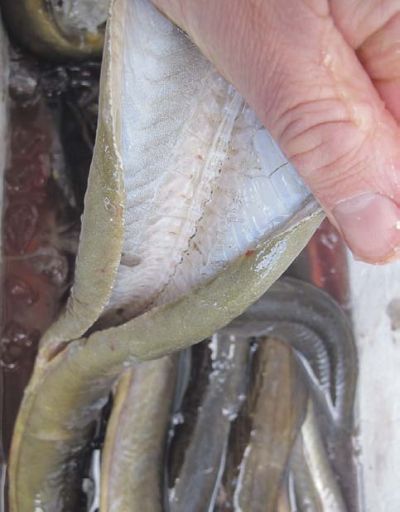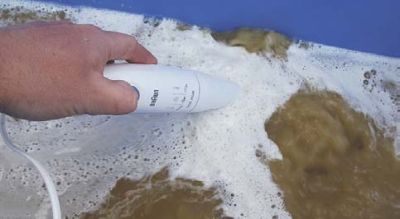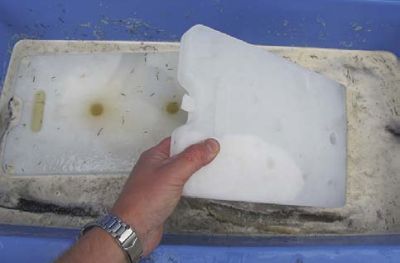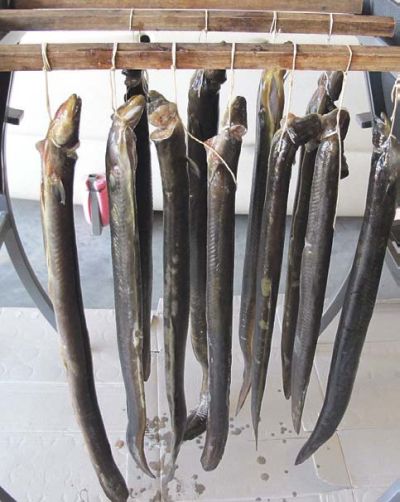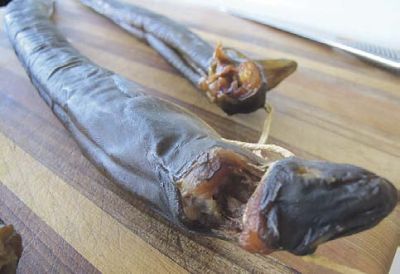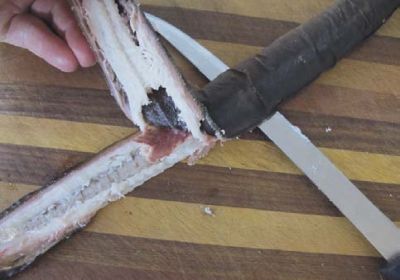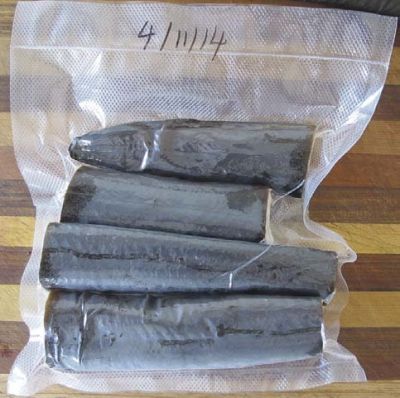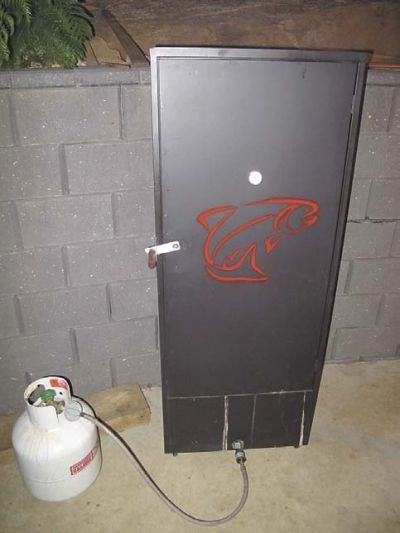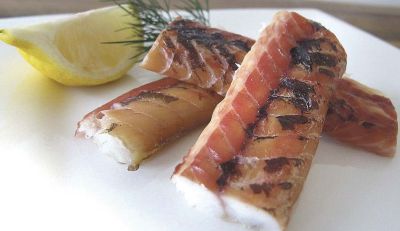 Presented from Issue 113, December 2014
Presented from Issue 113, December 2014
While not hugely popular in Tasmania, smoked eel is considered a true delicacy in many countries. It is particularly popular throughout Eastern Europe where it is often sold at a premium price. While it is rare to encounter this type of smoked product in Tassie, I have seen it at a one of the seafood establishments on Hobart’s waterfront. The sale price was over $50 per kilogram. You may be asking yourself, why so expensive? At that price, it must taste amazing, right?
Well, the answer is yes, it is expensive, but the taste is something special!
In my opinion, hot-smoked eel tastes a bit like crayfish, with the added flavour of smoke. The flesh is oily, and it is similar in appearance to that of cooked cray flesh. The high natural oil content of eel makes it the perfect fish to smoke.
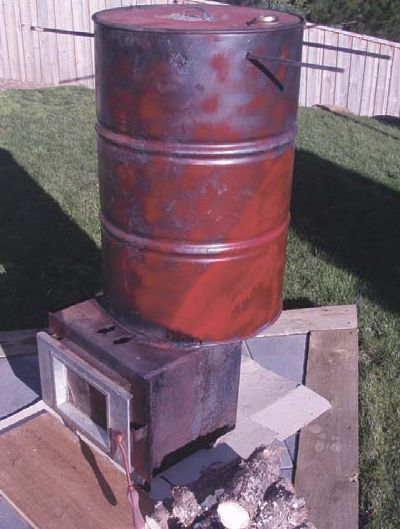 Smoking these slimy suckers takes me right back to my childhood here in Tassie. My Polish background meant that I was exposed to these skills from an early age, watching my father. These skills have since become the foundation of the techniques that I now use to successfully smoke trout. I have also made some killer smoked venison jerky in recent times – but that’s a recipe for another day!
Smoking these slimy suckers takes me right back to my childhood here in Tassie. My Polish background meant that I was exposed to these skills from an early age, watching my father. These skills have since become the foundation of the techniques that I now use to successfully smoke trout. I have also made some killer smoked venison jerky in recent times – but that’s a recipe for another day!
When I was a kid, my father would use a simple homemade wood-fired hot smoker made from a 44-gallon drum, which was very cheap and easy to do. As long as the fire was not too hot, this method worked very well. Unfortunately, the downside to this technique was the need to constantly supervise the fire to ensure that it did not get too hot, and also that it did not go out. As you may have already guessed, this turned out to be the perfect job for a kid such as myself!
So if you are new to ‘smoking’, the method described might just be a great introduction to this cooking technique. Get on the internet and Google it – you will soon find plenty of suggestions! Otherwise check out one of the smokers that I have made from an old wood heater fire box and 44 gallon drum.
These days, all of the eel (and trout) I smoke is ‘hot- smoked’ in my homemade gas powered smokehouse, which I made from an old steel clothes-drying cupboard. Controlling temperature, which is more difficult with the setups described earlier, is a lot easier with this gas- powered setup. There are also many electric and gas powered smokers available commercially, with some available at your local tackle store. They do cost a bit, but on the upside they are simple to operate will generally produce a consistently good product.
Catching eels
The best time to catch eels is in the summer months. They are very active at night when it is warmer and this is the time you should be targeting them. No special gear is required. A solid bait rod with at least 10 lb mono line will do the job just fine. A thicker breaking strain line doesn’t matter because they are not fussy with the presentation. It is also probably advantageous to use thicker stuff because the big ones can take some getting in. Once hooked, they have a nasty habit of wrapping themselves around any submerged tree roots or logs.
When I was a kid, my father would use 30 lb line or heavier and he would literally drag them up the bank! Most freshwater rivers are good starting points for this type of fishing. The South Esk, North Esk, Macquarie and Meander rivers all have big populations of eel. Simply set your rod up with a running sinker rig similar to what you would use for trout. Use a small gape long shank hook and stick a heap of fresh garden worms on it. Grab a comfy chair and wait! It’s that simple. You will know an eel is having a go at your bait when you feel a long series of subtle bites or even pulls. Don’t expect an aggressive take like a trout or even a flathead – eels don’t do that. When you feel the bites, be patient and give them a few opportunities to have a go at your bait.
Once you have given them a chance to get the bait into their small mouth, it is time to set the hook! I should also mention that I like to have a plastic bin with a lid close by. This bin is filled with an ice slurry (fresh water and ice) and the eels go straight into this.
Make sure you also have an old towel handy for handling the eel (and wiping yourself down), because the slime sticks to everything. They also like to wrap themselves around your hand and the slime does not come off clothing easily. It should also be noted that the eel is a hardy creature and although the ice slurry will slow them down you may find you will have to dispatch them properly once you get home.
IFS regulations
An IFS Recreational Angling licence is needed to take freshwater eel in Tasmania.
Minimum size: 300 mm
Bag limit: 12 fish
Cleaning your eels
Remember that any fish will begin to spoil the minute you land it. Enzymes and bacteria go to work straight away and they will take away flavour from your fish and break down the flesh.
Bleed your eel using a quick cut behind the head, but keep the head on (I will explain why later). Make sure that you remove all traces of the bloodline (which runs along the backbone). Using a small teaspoon can make this task quick and easy. A small plastic nailbrush is another great little tool for this task (you can use it to scrub away the bloodline).
Once you have gutted and cleaned the insides of your eel it is ready to be brined. There is no need to take the skin off. Keeping the skin on the eel actually helps to keep the moisture in during the smoking process.
Brining
Basic Eel Brine:
- 6 litres of cold water
- 2 cups of table salt (non-iodised)
- 2 cups of brown sugar
Hint: using the above ingredients as a brine base, try adding freshly crushed garlic cloves, sliced onion or fresh herbs such as finely chopped dill. They will impart more flavour into the final product.
Add cold water to a suitable receptacle with a lid. An old esky is perfect. Add all of the above ingredients. The next step is to dissolve everything really well in the water. I use a stick blender to do this quickly and effectively.
The resulting brine should be a weak to mild tasting one. I always taste it, just to make sure that it is not too salty. If you can handle the salt level of your brine during this tasting, then you are headed in the right direction with your recipe. If the taste is too salty, you can always add more water. If you follow the quantities suggested in the recipe above though, you shouldn’t have any problems.
Once the brine is ready, submerge the eels (whole) in the brine. Make sure that you only use eels that are fresh. Seal your container or esky with the lid and leave the eel in it for 24 to 48 hours. If it is a hot day and you are worried about spoilage, then a plastic soft drink bottle of water that has been frozen can be added to the brine. This will ensure that the contents remain appropriately cooled.
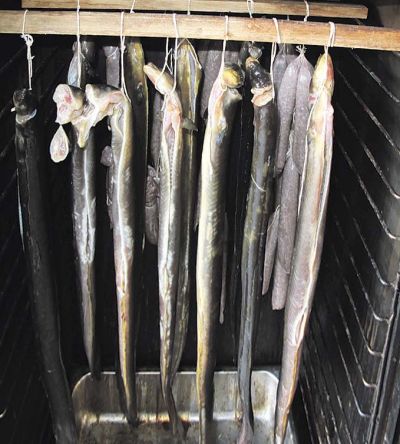 |
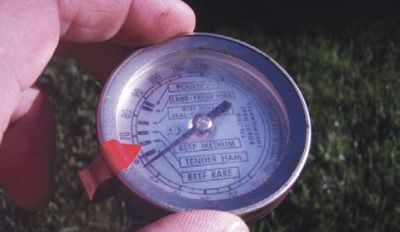 |
| Check the temperature carefully and don’t let it get too hot. |
Air drying
After the recommended time period, remove the eel from the brine. The brine will be slimy and horrible looking, but shouldn’t smell off. Discard the brine, as it cannot be used again. Grab a clean towel and give each eel a wipe-down to get the slime off. Because the brine recipe is quite weak, it is important that you do not rinse the eel in fresh water.
Timber rod dowels are used to hang the eels in my smoker. Set these up in your drying area (a closed garage away from any flies) and tie the eels on. Use cotton twine to hang each eel by the head from the dowels. Cotton twine is a must, as it doesn’t burn easily. You should be able to get it from the supermarket or your local butcher. Leave the eels to air dry for at least 2 hours (this will depend on the temperature). The skin should be fairly dry to touch, although a little tackiness is fine. This drying process is crucial as it allows the formation of, what is called, a ‘pellicle’ on the skin. In short, this step helps to seal in the moisture and preserve the end product.
Hot Smoking (in a gas powered or electric smoker)
Your smoker will need to be fired up well in advance (a good 30 minutes). You are aiming to get the smoker to a temperature of 60°C. Place the desired wood chips in your smoker box. I often use American mesquite (try Bunnings or ask at your tackle store), due to the light smoke flavour that this wood imparts. However, more recently I have used silver birch, with great results. There are also many other woods that are suitable for smoking eel. Wood obtained from fruit trees is widely used throughout Europe; you could try apple, pear, cherry, apricot or even plum. But avoid using resinous woods such as pine or citrus. They will impart an unpleasant bitter flavour to your fish.
Aim for a very light smoke by not using too many chips at once. Once you have reached the required temperature and the smoke level is appropriate, it is time to load the smoker. Place the dowels at the top of the smoker. The eels should be suspended from them with the cotton twine by their heads. It is important that the eels do not touch each other once you have them positioned in the smoker. Most smokers will take dowels that you have cut to fit. They will slide in where the top rack usually sits. However, you may have to modify your smoker, depending on the type that you have. Close the door and smoke the eels at 60°C for the next three hours. Then, for the last hour (four hours in total), increase the temperature to 80°C. The last hour at a higher temperature will ensure that any potentially harmful bacteria are destroyed. A bit over 80°C is fine, but be careful not to bake the eels!
After four hours, the smoked eel should be ready. The end product should have a dark golden colour. When pushed with your finger, the flesh should feel firm, but still be moist. If it is mushy, then the eel will need a little more time in the smoker. Obviously, the bigger the fish, the more time that will be required. A good indication of whether they are smoked properly is to look at the eyes. If the eyes are white (like a hard-boiled egg), then your eel is properly smoked and ready to eat.
Storage
Just like all smoked fish, smoked eel should be stored in the refrigerator at all times. If you have access to a vacuum sealer, then the life of your product can be extended significantly. Eel smoked using this method (and vacuum sealed) will keep for around four weeks if stored under 4°C in your refrigerator; however, make sure that the fish are completely cooled before sealing. Vacuum sealed and frozen, smoked eel will keep for up to 12 months. Cutting them up into smaller lengths will enable you to fit quite a few into one of the larger bags. As a final note, be sure to exercise proper food hygiene. That means clean your hands, utensils, chopping board and any other equipment that you have used throughout the process.
Smoked Eel Fillets
This is something that I discovered watching a documentary on eel smoking in Norway not that long ago. After smoking your eel, let it cool. Grab the whole thing and with a very sharp fillet knife remove the fillets. Start at the tail and work along the backbone of the smoked eel. Next, cut the ribcage out of each fillet. You can then simply ‘pull off’ the skin from the fillet. You are now left with a gourmet sensation that is both ‘boneless’ and very appealing to your guests. Serve with a slice of lemon and enjoy! And don’t forget, smoked eel can also be stirred through your favourite pasta or salad.

Smoked Eel Pate
Ingredients
- 1 x small handful of shredded smoked eel flesh
- 1 x tub Philadelphia cream cheese
- 1 tbsp. horseradish cream (Horlein brand available at Coles)
- Freshly chopped dill or chives
- Juice and rind of 1 x lemon
- Salt & Pepper to taste
Whiz everything up in a food processor and enjoy with some crackers and cold white wine!
- Note: you can substitute the smoked eel with smoked trout too.
Conclusion
The eel industry is huge in many countries. Even our own state has several licenced harvesters who net these fish and export them all over the globe. Smoking eel is just one form of preparing this tasty fish. There are many other recipes for it out there, such as deep fried eel, which I am told is also super tasty. So the next time you encounter that slimy eel, think again, it might just be worth keeping!
Michal Rybka
IFS information:
https://www.ifs.tas.gov.au/about-us/publications/fish-fact-sheets/short-finned-eel
https://www.ifs.tas.gov.au/about-us/publications/fish-fact-sheets/long-finned-eel
Preparartion Gallery
